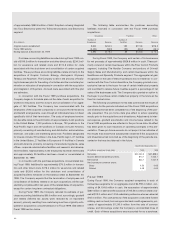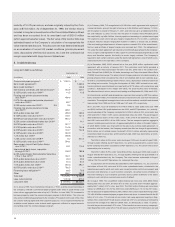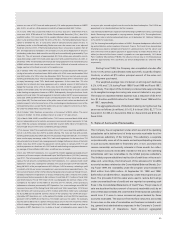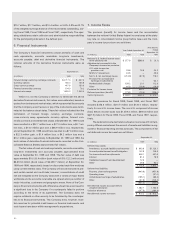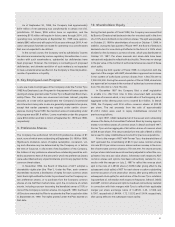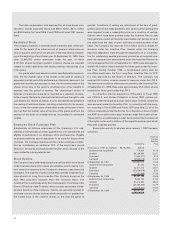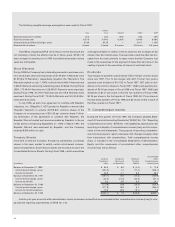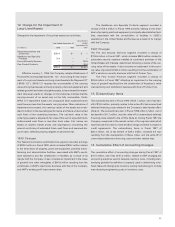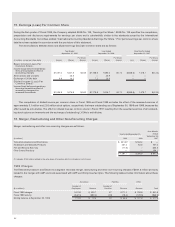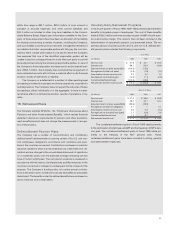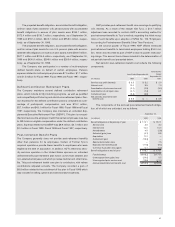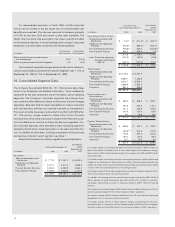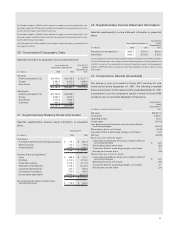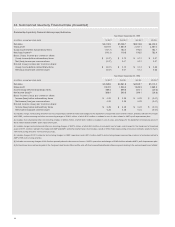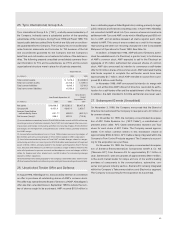ADT 1999 Annual Report Download - page 57
Download and view the complete annual report
Please find page 57 of the 1999 ADT annual report below. You can navigate through the pages in the report by either clicking on the pages listed below, or by using the keyword search tool below to find specific information within the annual report.
55
12. Charge for the Impairment of
Long-Lived Assets
Charges for the impairment of long-lived assets are as follows:
Nine Months
Ended
Year Ended September 30,
September 30,
(in millions) 1999 1998 1997
Telecommunications and
Electronics $259.0 $
—
$
—
Healthcare and Specialty
Products 76.0
——
Fire and Security Services
——
118.8
Flow Control Products
——
29.6
$335.0 $
—
$148.4
Effective January 1, 1996, the Company adopted Statement of
Financial Accounting Standards No. 121, “Accounting for the Impair-
ment of Long-Lived Assets and Long-Lived Assets to Be Disposed Of”
(“SFAS 121”). SFAS 121 requires the recoverability of the carrying
value of long-lived assets, primarily property, plant and equipment and
related goodwill and other intangible assets, to be reviewed for impair-
ment whenever events or changes in circumstances indicate that the
carrying amount of an asset may not be fully recoverable. Under
SFAS 121 impairment losses are recognized when expected future
cash flows are less than the assets’ carrying value. When indicators of
impairment are present, the carrying values of the assets are evalu-
ated in relation to the operating performance and future undiscounted
cash flows of the underlying business. The net book value of the
underlying assets is adjusted to fair value if the sum of expected future
undiscounted cash flows is less than book value. Fair values are
based on quoted market prices and assumptions concerning the
amount and timing of estimated future cash flows and assumed dis-
count rates, reflecting varying degrees of perceived risk.
1999 Charges
The Telecommunications and Electronics segment recorded a charge
of $259.0 million in Fiscal 1999, which includes $198.2 million related
to the write-down of property, plant and equipment, primarily manu-
facturing and administrative facilities, associated with AMP’s world-
wide operations and the combination of facilities as a result of its
merger with the Company. It also includes an impairment in the value
of goodwill and other intangibles of $60.8 million resulting from the
combination of AMP’s electronics business with that of the Company
and AMP’s existing profit improvement plan.
The Healthcare and Specialty Products segment recorded a
charge of $76.0 million in Fiscal 1999 primarily relating to the write-
down of property, plant and equipment, principally administrative facil-
ities, associated with the consolidation of facilities in USSC’s
operations in the United States and Europe as a result of its merger
with the Company.
1997 Charges
The Fire and Security Services segment recorded a charge of
$118.8 million in Fiscal 1997, which includes $98.8 million related to
subscriber security systems installed at customers’ premises in the
United States and Canada, determined following a review of the car-
rying value of the assets. It also includes an impairment in the carry-
ing value of goodwill of $20.0 million resulting from the combination of
ADT’s electronic security business with that of Former Tyco.
The Flow Control Products segment recorded a charge of
$29.6 million in Fiscal 1997 reflecting an impairment in the carrying
value of goodwill resulting from the combination of Keystone’s valve
manufacturing and distribution business with that of Former Tyco.
13. Extraordinary Items
The extraordinary item in Fiscal 1999 of $45.7 million, net of tax ben-
efit of $18.0 million, primarily relates to the write-off of net unamortized
deferred financing costs related to the Company’s debt tender offers
(Note 4). The extraordinary item in Fiscal 1998 of $2.4 million, net of
tax benefit of $1.2 million, was the write-off of unamortized deferred
financing costs related to the LYONs (Note 4). During Fiscal 1997 the
Company reacquired in the market certain of its long-term debt which
was financed from cash on hand and borrowings under the Company’s
credit agreements. The extraordinary items in Fiscal 1997 of
$58.3 million, net of tax benefit of $33.0 million, included the loss
resulting from the reacquisition of these notes, and the write-off of
unamortized deferred refinancing costs and other related fees.
14. Cumulative Effect of Accounting Changes
The cumulative effect of accounting changes during Fiscal 1997 of
$15.5 million, net of tax of $7.4 million, related to AMP changing the
accounting practices used to develop inventory costs, including stan-
dardizing globally the definition of capacity used in determining over-
head rates and changing its inventory costing methodology to include
manufacturing engineering costs in inventory costs.



